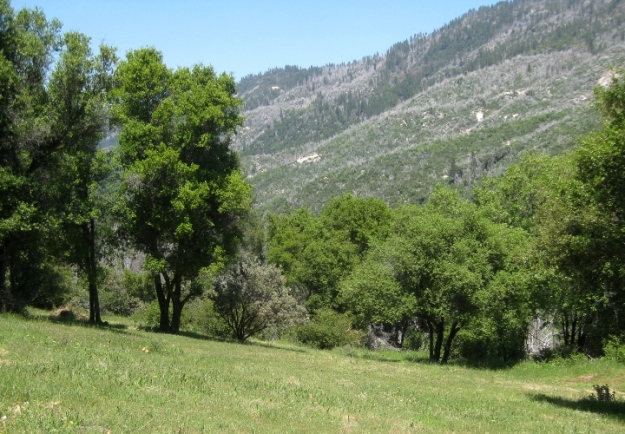Sitting…looking up at oaks
The Oaks of the Sierra foothills
“I am sitting with a philosopher in the garden; he says again and again ‘I know that that’s a tree’, pointing to a tree that is near us. Someone else arrives and hears this, and I tell him: ‘This fellow isn’t insane. We are only doing philosophy.”
— Ludwig Wittgenstein, on Certainty
You can sit nowhere in Sierra Foothill Garden without seeing an oak. The mighty oak. These are the three varieties we have. I say the word ‘have’ loosely because I feel I’m here temporarily, as Indian Guy from “Ernest goes to Camp’ says “Who can own a tree? ” (Don’t these two quotes prove that I am well cultured?)
Interior Live Oak
The Interior Live Oak, Quercus wislizenii, is one of the red oaks, living mostly in the lower elevations of the Sierra Nevada. The leaves are oval and toothed and the flowers are catkins that hang down from the branch tips. They are often shrubby and when cut down, will regrow thickly from the base. In April the catkins drop powdery yellow dust over all things near it and can cause allergies. Also in April the oak worms spin webs all through the branches, reflecting the sun.
California Black Oak
California Black Oak , Quercus kelloggii, is also in the red oak family and has leaves that are deeply lobed, pointed and sometimes as large as your hand. Taller in size and more upright than the Interior oak, the Black Oak is 30-70 ft in height and deciduous, making it very desirable in the garden because it turns bright gold, orange and red in the fall. The large leaves of the California Black Oak Quercus kelloggii, turn yellow in November.
Oracle oaks
Oracle oaks, Quercus morehus, only occurs in areas where there are lots of one of the parent species and not many of the other parent and between Oak ‘sub-tribes’ that are related to each other. The leaf looks like a cross between the big lobed Black Oak leaf and the small, sometimes serrated Live Oak leaf. It is an interesting occurrence and they are beautiful trees. They are deciduous and turn a mellow gold in Fall.
More on this rare oak: Discovering and identifying the Oracle Oak
A. California Black Oak (Q. kelloggii), a tall, deciduous tree; B. Interior Live Oak (Q. wislizenii var. frutescens), a large, evergreen shrub; C. Oracle Oak (Q. x morehus)
***
I have lunch out here most nice days. If I come out without Maggie seeing, and when she does notice, she bangs on the screen door and causes such a fit that Tractor Man has to let her out. She usually wanders away when left on her own outside and we’re not keeping track, but not when I have a sandwich!
If you happen to like using flea market finds, like this old lounge shown here, and other junkola as garden art and decoration, you may like this FB page Flea Market Gardening. Check it out, won’t you?
***
More foothill oaks…
Blue Oaks
Blue Oaks, or Quercus douglasii, are endemic to California, only found here in our state and can commonly be found in the lower elevations of the Madera County foothills about 2000 feet, but can appear as high as 4000 feet in some areas of California. The bluish color is caused by a waxy coating on its leaves and you can easily see the blue among the yellow-green of the Interior oaks along Hwy 49 through Ahwahnee. A deciduous tree, the Blue oak was highly valued by local native tribes for their nutritious acorns.
The Blue Oak is very hardy with tough, thick bark that allows it to withstand drought and prolonged temperatures over 100°. They don’t like to be shaded, so won’t be found as understory trees like the Oracle oak.
Valley Oaks
Valley Oak, Quercus lobata, are the wide majestic oaks, you see in the lower elevations before reaching the valley
Valley Oaks, Quercus lobata, AKA White Oak, Swamp Oak, Roble Oak and California White Oak are also deciduous and is the fastest growing of our California oaks, growing up to 20 feet a year, with plenty of water, to 70 feet and as wide. You’ll notice them growing thickly on the north sides of each foothill throughout the cattle county of eastern Madera County. Their branches dip as low as the ground as they offer shelter to wise livestock.
Notes:
For more on the trees here, see Trees and Shrubs in the Existing Native Plants tab.
For what to plant under oaks and pines see this post.
Recent Posts
How to Be a Lazy Gardener
...and still have a pretty garden With a busy household and jobs, we are…
Summer is Spring at Whiskey Falls!
Take a day trip to Whiskey Falls... Come visit Whiskey Falls and the surrounding high…
California oak acorns: Feast or famine
Why do oaks drop more acorns some years and not others? If you have live…
Mule’s ear and Farewell to Spring
Roadside treasures worth stopping for In the first week of July in the Sierra foothills…
Our favorite butterfly plants
Wow! Butterflies love these plants! Grow any of these for instant results and each is…
A water-saving veggie garden for the foothills
Your water-wise veggie garden Does everyone in our Mountain Community grow at least one tomato?…



